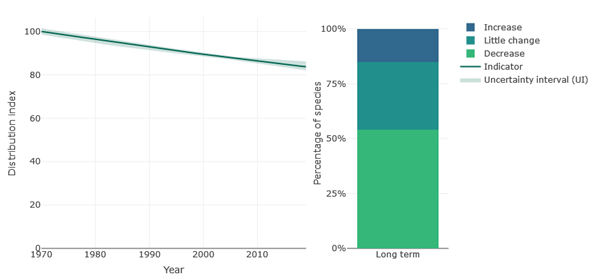More than 60 conservation and research organisations worked together to produce the State of Nature report for 2023. They used data from biological monitoring and recording schemes to present an objective assessment of the state of nature in the UK and how it has changed over the past 50 years. It provides crucial information for understanding the actions needed to support UK wildlife. The report for 2023 revealed big changes in wildlife. Notably, 38% of species have seen their populations decrease and 16% of species are threatened with extinction from Great Britain. It also highlighted the positive impacts of conservation efforts. For example, large-scale restoration projects such as Cairngorms Connect are benefitting many woodland-dependent species. Further details on the 2023 report can be found here.

Dr Francesca Mancini, an ecological modeller at the UK Centre for Ecology and Hydrology (UKCEH) and a co-author of the report, says:
While the report shows there are declines in many wildlife populations, it is possible to reverse biodiversity losses through habitat restoration, sustainable agricultural practices and mitigating climate change, for example. Our findings will inform future conservation action to support species.
The report uses the latest and best data from biological monitoring and recording schemes that rely on the efforts of thousands of skilled people, most of whom are volunteers, from over 60 partners (non-governmental organisations, research institutes, statutory nature conservation bodies). One scheme that provides valuable data is the National Plant Monitoring Scheme which collects information on the abundance and diversity of plants. These data are available from one of the NERC EDS’s Data Centres; the Environmental Information Data Centre (EIDC) hosted at the UKCEH. Download them here: https://catalogue.ceh.ac.uk/documents/3c5ce16f-8738-459a-b432-bc01f8f40424.
Dr Mancini used DataLabs to work collaboratively to contribute to this most comprehensive assessment of UK species and habitats. DataLabs is a collaborative, scalable, and dynamic digital research platform that requires only a web browser to access high-powered computer facilities and big data storage in the cloud. It is developed by NERC EDS researchers, based at the UKCEH. Further details can be found in Holloway et al., (2020) and in this earlier EDS impact article.
Dr Mancini worked with five other researchers from four different organizations to generate evidence. They worked with approximately 6 Terabytes (TB) of data and over 40 scripts.
The opportunity to store large amounts of data and analysis scripts in a location accessible by multiple users from different organisations has allowed us to work more effectively as a team to produce these outputs. Using DataLabs allowed us to share analysis code and outputs… DataLabs made working together to produce this important piece of evidence a more efficient and streamlined process.
Storing these data and scripts in DataLabs means they can be easily accessed and used in future projects such as the next State of Nature report. This will help us better understand the current pressures on the UK’s wildlife and plants and how they are responding to them.
References
Burns, F, Mordue, S, al Fulaij, N, Boersch-Supan, PH, Boswell, J, Boyd, RJ, Bradfer-Lawrence, T, de Ornellas, P, de Palma, A, de Zylva, P, Dennis, EB, Foster, S, Gilbert, G, Halliwell, L, Hawkins, K, Haysom, KA, Holland, MM, Hughes, J, Jackson, AC, Mancini, F, Mathews, F, McQuatters-Gollop, A, Noble, DG, O’Brien, D, Pescott, OL, Purvis, A, Simkin, J, Smith, A, Stanbury, AJ, Villemot, J, Walker, KJ, Walton, P, Webb, TJ, Williams, J, Wilson, R, Gregory, RD, 2023. State of Nature 2023, the State of Nature partnership, Available at: State of Nature, https://stateofnature.org.uk/
Holloway, M. J., Dean, G., Blair, G. S., Brown, M., Henrys, P. A., Watkins, J. (2020) Tackling the challenges of 21st Century open science and beyond: A Data Science Lab approach. Patterns Vol 1, issue 7, 100103. https://doi.org/10.1016/j.patter.2020.100103
NERC Environmental Data Service, DataLabs – Digital Collaborative Platform Tackling Environmental Science Challenges, https://eds.ukri.org/index.php/news/impacts/datalabs-digital-collaborative-platform-tackling-environmental-science-challenges
NERC Environmental Information Data Centre, National Plant Monitoring Scheme Data Collection, https://catalogue.ceh.ac.uk/documents/3c5ce16f-8738-459a-b432-bc01f8f40424